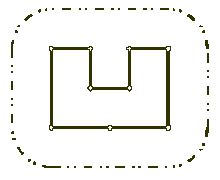Wall 凸包
Wall
Time Limit: 2000/1000 MS (Java/Others) Memory Limit: 65536/32768 K (Java/Others)Total Submission(s): 2241 Accepted Submission(s): 613
Your task is to help poor Architect to save his head, by writing a program that will find the minimum possible length of the wall that he could build around the castle to satisfy King's requirements.

The task is somewhat simplified by the fact, that the King's castle has a polygonal shape and is situated on a flat ground. The Architect has already established a Cartesian coordinate system and has precisely measured the coordinates of all castle's vertices in feet.
Next N lines describe coordinates of castle's vertices in a clockwise order. Each line contains two integer numbers Xi and Yi separated by a space (-10000 <= Xi, Yi <= 10000) that represent the coordinates of ith vertex. All vertices are different and the sides of the castle do not intersect anywhere except for vertices.
This problem contains multiple test cases!
The first line of a multiple input is an integer N, then a blank line followed by N input blocks. Each input block is in the format indicated in the problem description. There is a blank line between input blocks.
The output format consists of N output blocks. There is a blank line between output blocks.
1 9 100 200 400 300 400 300 300 400 300 400 400 500 400 500 200 350 200 200 200
1628
#include <cmath>
#include <cstdio>
#include <cstdlib>
#include <iostream>
using namespace std;
const int N = 1005;
const double PI = 3.1415927;
struct point
{
double x;
double y;
}p[N], stack[N];
double dis(point A, point B)
{
return sqrt((A.x-B.x)*(A.x-B.x)+(A.y-B.y)*(A.y-B.y));
}
double crossProd(point A, point B, point C)
{
return (B.x-A.x)*(C.y-A.y) - (B.y-A.y)*(C.x-A.x);
}
//以最左下的点为基准点,其他各点(逆时针方向)以极角从小到大的排序规则
int cmp(const void *a, const void *b)
{
point *c = (point *)a;
point *d = (point *)b;
double k = crossProd(p[0], *c, *d);//极角大小转化为求叉乘
if (k<0 || !k && dis(p[0], *c)>dis(p[0], *d)) return 1;
return -1;
}
double Graham(int n)
{
double x = p[0].x;
double y = p[0].y;
int mi = 0;
for (int i=1; i<n; ++i) {//找到最左下的一个点
if (p[i].x<x || (p[i].x==x && p[i].y<y))
{
x = p[i].x;
y = p[i].y;
mi = i;
}
}
point tmp = p[mi];
p[mi] = p[0];
p[0] = tmp;
qsort(p+1, n-1, sizeof(point), cmp);
p[n] = p[0];
stack[0] = p[0];
stack[1] = p[1];
stack[2] = p[2];
int top = 2;
for (int i=3; i<=n; ++i) {//加入一个点后,向右偏拐或共线,则上一个点不在凸包内,则--top,该过程直到不向右偏拐或没有三点共线的点
while (crossProd(stack[top-1], stack[top], p[i])<=0 && top>=2) --top;
stack[++top] = p[i];//在当前情况下符合凸包的点,入栈
}
double len = 0;
for (int i=0; i<top; ++i) len += dis(stack[i], stack[i+1]);
return len;
}
int main()
{
int t;
while (scanf("%d", &t) != EOF)
{
while (t--) {
int n, l;
scanf ("%d%d", &n, &l);
for (int i=0; i<n; ++i)
scanf ("%lf%lf", &p[i].x, &p[i].y);
double ans = Graham(n);
ans += PI * (l + l);
printf ("%.0lf\n", ans);
if (t)
printf ("\n");
}
}
return 0;
}